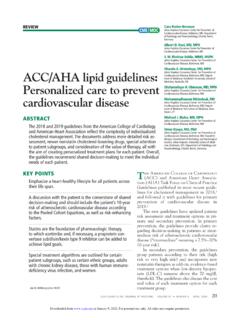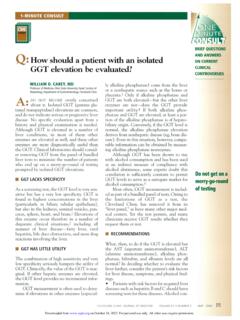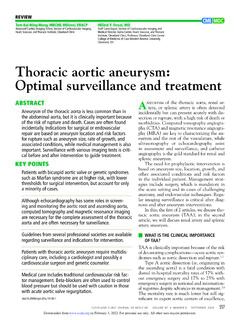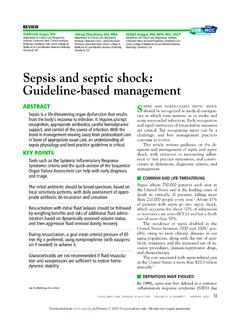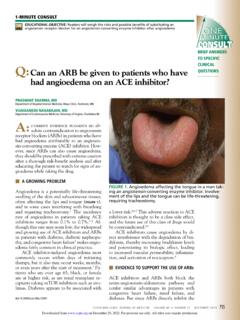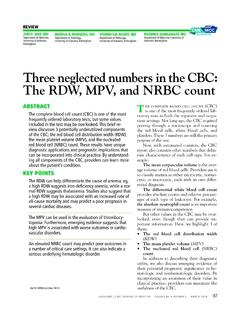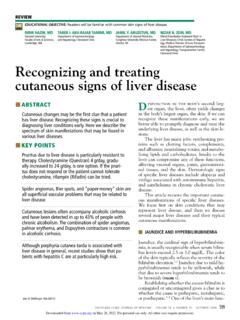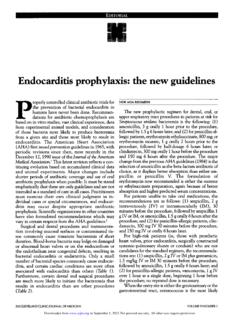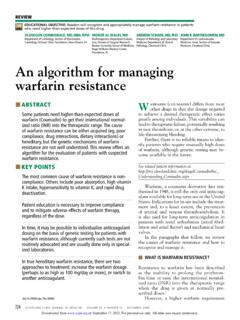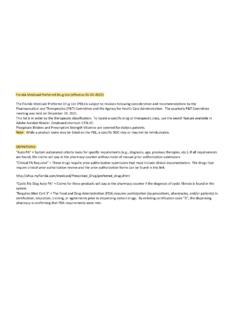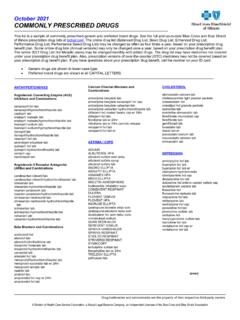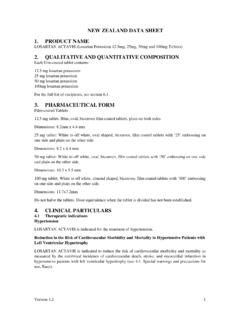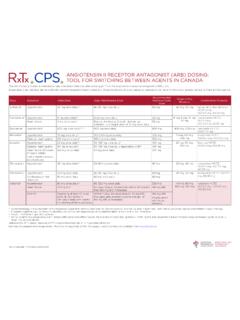Transcription of ACE inhibitors and ARBs: Managing potassium and renal …
1 ACE inhibitors and ARBs: Managing potassium and renal functionCLEVELAND CLINIC JOURNAL OF MEDICINE VOLUME 86 NUMBER 9 SEPTEMBER 2019 601A highly active, water- and alcohol-soluble, basic pressor substance is formed when renin and renin-activator interact, for which we suggest the name angiotonin. Irvine H. Page and O. M. Helmer, renin-angiotensin-aldosterone sys-tem regulates salt and, in part, water ho-meostasis, and therefore blood pressure and fluid balance through its actions on the heart, kid-neys, and blood Drugs that target this system angiotensin-converting enzyme (ACE) inhibitors and angiotensin II receptor blockers (ARBs) are used primarily to treat hyperten-sion and also to treat chronic kidney disease and heart failure with reduced ejection related editorial, page 608 Controlling blood pressure is important, as hypertension increases the risk of myocardial infarction, cerebrovascular events, and pro-gression of chronic kidney disease, which itself is a risk factor for cardiovascular disease.
2 How-ever, the benefit of these drugs is only partly due to their effect on blood pressure. They also reduce proteinuria, which is a graded risk fac-tor for progression of kidney disease as well as morbidity and death from vascular Despite the benefits of ACE inhibitors and ARBs, concern about their adverse effects especially hyperkalemia and a decline in renal function has led to their underuse in patients likely to derive the greatest ACE inhibitors AND ARBsThe renin-angiotensin-aldosterone system is activated when hypoperfusion to the glomeru-lar afferent arteriole, reduced sodium delivery to the distal convoluted tubule, or increased CURRENT DRUG THERAPYABSTRACTA ngiotensin-converting enzyme (ACE) inhibitors and an-giotensin II receptor blockers (ARBs)
3 Are used primarily to treat hypertension and are also useful for conditions such as heart failure and chronic kidney disease, independent of their effect on blood pressure. This article reviews the indications for ACE inhibitors and ARBs and offers advice for Managing their adverse effects, particularly declining renal function and POINTSACE inhibitors and ARBs reduce proteinuria by lowering the intraglomerular pressure, reducing hyperfiltration. These drugs tend to raise the serum potassium level and reduce the glomerular filtration rate (GFR). Monitoring the serum potassium and creatinine levels and the GFR is therefore the benefits, concern for adverse effects including hyperkalemia and a rise in serum creatinine has led to re-luctance to prescribe these drugs, and they are underused in the patients who may derive the greatest MOMONIAT, MBCHB, MRCP (UK)Department of Nephrology, Hull University Teaching Hospitals NHS Trust, East Yorkshire, UKDUHA ILYAS, MBBS, MRCP (UK)
4 Department of Nephrology, Hull University Teaching Hospitals NHS Trust, East Yorkshire, UKSUNIL BHANDARI, MBCHB, FRCP, PhD, M CLIN EDU, FHEAD epartment of Nephrology, Hull University Teaching Hospitals NHS Trust, East Yorkshire, UK602 CLEVELAND CLINIC JOURNAL OF MEDICINE VOLUME 86 NUMBER 9 SEPTEMBER 2019 ACE inhibitors AND ARBssympathetic activity stimulates the renal jux-taglomerular apparatus to produce renin (Fig-ure 1). This leads to a cascade of effects cul-minating in sodium retention and potassium excretion, thus increasing blood pressure. ACE inhibitors , as their name indicates, inhibit conversion of angiotensin I to angio-tensin II by ACE, resulting in vasodilation of the efferent arteriole and a drop in blood pres-sure.
5 Inhibition of ACE, a kininase, also re-sults in a rise in kinins. One of these, bradyki-nin, is associated with some of the side effects of this class of drugs such as cough, which af-fects 5% to 20% of Elevation of bra-dykinin is also believed to account for ACE inhibitor-induced angioedema, an uncommon but potentially serious side effect. Kinins are also associated with desirable effects such as lowering blood pressure, increasing insulin sensitivity, and dilating blood vessels. ARBs were developed as an alternative for patients unable to tolerate the adverse effects of ACE inhibitors . While ACE inhibitors re-duce the activity of angiotensin II at both the AT1 and AT2 receptors, ARBs block only the AT1 receptors, thereby inhibiting their vaso-constricting activity on smooth muscle.
6 ARBs also raise the levels of renin, angiotensin I, and angiotensin II as a result of feedback inhibi-tion. Angiotensin II is associated with release of inflammatory mediators such as tumor ne-crosis factor alpha, cytokines, and chemokines, the consequences of which are also inhibited by ARBs, further preventing renal fibrosis and scarring from chronic is the evidence supporting the use of ACE inhibitors and ARBs?ACE inhibitors and ARBs, used singly, reduce blood pressure and proteinuria, slow progression of kidney disease, and improve outcomes in pa-tients who have heart failure, diabetes mellitus, or a history of myocardial 11 While dual blockade with the combina-tion of an ACE inhibitor and an ARB low-ers blood pressure and proteinuria to a greater degree than monotherapy, dual blockade has been associated with higher rates of complica-tions, including 17 RISK FACTORS FOR HYPERKALEMIAACE inhibitors and ARBs raise potassium , especially when used in combination.
7 Other risk factors for hyperkalemia include the fol-lowing and note that some of them are also indications for ACE inhibitors and ARBs: renal insufficiency. The kidneys are re-sponsible for over 90% of potassium removal in healthy individuals,18,19 and the lower the GFR, the higher the risk of ,20,21 Heart failure Diabetes mellitus6,21 23 Endogenous potassium load due to hemo-lysis, rhabdomyolysis, insulin deficiency, lactic acidosis, or gastrointestinal bleeding Exogenous potassium load due to dietary consumption or blood products Other medications, eg, sacubitril-valsar-tan, aldosterone antagonists, mineralocorti-coid receptor antagonists, potassium -sparing diuretics, beta-adrenergic antagonists, non-steroidal anti-inflammatory drugs, heparin, cyclosporine, trimethoprim.
8 Digoxin Hypertension Hypoaldosteronism (including type 4 re-nal tubular acidosis) Addison disease Advanced age Lower body mass benefit of these drugs is only partly due to their effect on blood pressureAngiotensinogen Renin Direct renin inhibitor (aliskiren)Angiotensin I Angiotensin-converting enzyme (ACE) ACE inhibitors (benazepril, captopril, enalapril, lisinopril, ramipril) Angiotensin II Angiotensin II receptor blockers (ARBs) (candesartan, irbesartan, losartan , valsartan)Aldosterone Aldosterone antagonists (spironolactone, eplerenone)Target cells Mineralocorticoid antagonistsIncreased sodium absorption, potassium excretion, fluid retentionFigure 1.
9 The renin-angiotensin-aldosterone system and drugs that inhibit CLINIC JOURNAL OF MEDICINE VOLUME 86 NUMBER 9 SEPTEMBER 2019 603 MOMONIAT AND COLLEAGUES Both hypokalemia and hyperkalemia are as-sociated with a higher risk of death,20,21,24 but in patients with heart failure, the survival benefit from ACE inhibitors , ARBs, and mineralocor-ticoid receptor antagonists outweighs the risk of 27 Weir and Rolfe28 conclud-ed that patients with heart failure and chronic kidney disease are at greatest risk of hyperka-lemia from renin-angiotensin-aldosterone sys-tem inhibition, but the increases in potassium levels are small (about to mmol/L) and unlikely to be clinically significant.
10 Hyperkalemia tends to recur. Einhorn et al20 found that nearly half of patients with chronic kidney disease who had an episode of hyperkalemia had 1 or more recurrent epi-sodes within a year. ACE inhibitors , ARBs, AND renal FUNCTIONA nother concern about using ACE inhibitors and ARBs, especially in patients with chronic kidney disease, is that the serum creatinine level tends to rise when starting these drugs,29 although several studies have shown that an acute rise in creatinine may demonstrate that the drug is actually protecting the ,31 Hirsch32 described this phenomenon as pre- renal success, proposing that the decline in GFR is hemodynamic, secondary to a fall in intraglomerular pressure as a result of efferent vasodilation, and therefore should not be re-versed.
